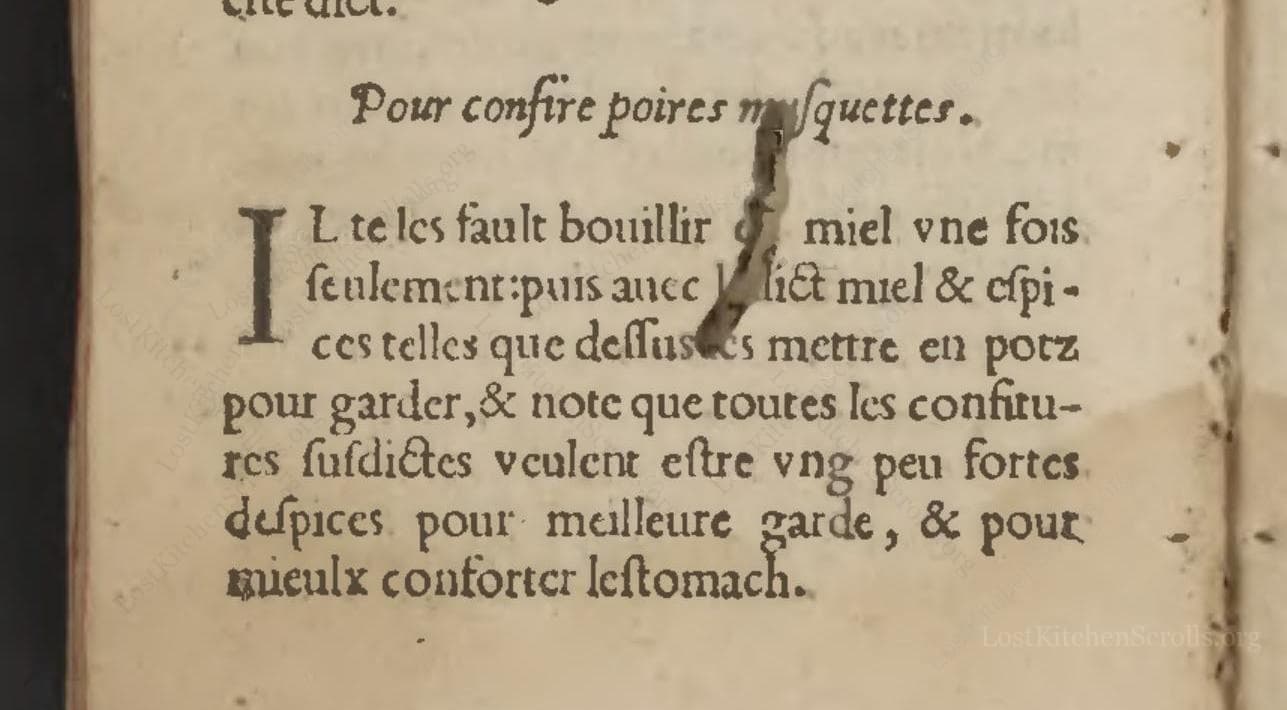Pour Confire Poires Musquettes
"To Preserve Muscat Pears"
From the treasured pages of Bastiment de receptes
Unknown Author

Pour Confire Poires Musquettes
"Il te les fault bouillir de miel vne fois seulement: puis auec lict miel & espices telles que dessus es mettre en potz pour garder, & note que toutes les confitures susdictes veulent estre vng peu fortes despices pour meilleure garde, & pour mieulx conforter lestomach."
English Translation
"You must boil them in honey just once: then, with clear honey and spices as mentioned above, put them in jars to keep, and note that all the above-mentioned preserves should have a little stronger spices for better preservation, and to better comfort the stomach."
Note on the Original Text
Recipes of this period were written for knowledgeable household cooks, offering guidance but assuming prior experience. They were brief, often lacking precise measurements or times, relying on the cook's senses and judgement. Spelling, especially in early modern French, can appear odd to us—'miel' for honey, 'potz' for pots, 'confiture' for preserves—reflecting both regional dialects and the standardization process that French would undergo in later centuries. The focus is on method and intent rather than strict instruction, blending culinary and medicinal logic.

Title
Bastiment de receptes (1541)
You can also click the book image above to peruse the original tome
Writer
Unknown
Era
1541
Publisher
A Lescu de Coloigne
Background
Step into the culinary secrets of Renaissance France! 'Bastiment de receptes' is a delectable compendium newly translated from Italian, brimming with recipes, curious odors, and medicinal tidbits designed to both delight the palate and preserve health.
Kindly made available by
Library of Congress
This recipe comes from the early Renaissance, specifically from 'Bastiment de receptes', published in Lyon in 1541. The book represents an era when both culinary and medicinal uses of food were intimately connected—the act of preserving fruit in honey was both a treat and a tonic. Like many period cookbooks, it reflected the blending of Italian influence into French culinary tradition, serving both the curious noble and the practical apothecary. Such preserves were both a sweetmeat and a digestive aid, suitable for refined tables and feasts.

Back in the 16th century, cooks worked over wood-fired stoves or hearths, using sturdy copper or ceramic pots for boiling. The honey would be heated in such a pot, the pears lowered in carefully. Preserved fruits were most often stored in glazed earthenware jars, sealed with parchment or a cloth tied with string and sometimes covered in wax to protect against spoilage.
Prep Time
20 mins
Cook Time
10 mins
Servings
8
We've done our best to adapt this historical recipe for modern kitchens, but some details may still need refinement. We warmly welcome feedback from fellow cooks and culinary historians — your insights support the entire community!
Ingredients
- 2.2 lbs small firm musk pears (or substitute with Bosc or Comice pears if unavailable)
- 1.5 lbs clear honey
- 1 tablespoon ground cinnamon
- 1 teaspoon ground cloves
- 1 teaspoon ground nutmeg
- 1 teaspoon ground ginger
Instructions
- To confit musk pears, begin by gently boiling the pears just once in honey.
- Remove the pears, then layer them in a sterilized jar, covering each layer with fresh honey mixed with a generous amount of warming spices—think cinnamon, cloves, nutmeg, and perhaps ginger, just as described in similar recipes of the period.
- Seal the jar and store it in a cool place.
- The honey and strong spices will both preserve the fruit and impart a delightful flavor, while also aiding digestion, as was highly valued in the Renaissance kitchen.
Estimated Calories
290 per serving
Cooking Estimates
Preparing and confiting the pears takes about 20 minutes of hands-on time, with an additional 10 minutes for gently simmering the fruit. Each serving is estimated using one pear and a portion of the spiced honey. The calorie count comes mostly from the honey, so enjoy in moderation.
As noted above, we have made our best effort to translate and adapt this historical recipe for modern kitchens, taking into account ingredients nowadays, cooking techniques, measurements, and so on. However, historical recipes often contain assumptions that require interpretation.
We'd love for anyone to help improve these adaptations. Community contributions are highly welcome. If you have suggestions, corrections, or cooking tips based on your experience with this recipe, please share them below.
Join the Discussion
Rate This Recipe
Dietary Preference
Main Ingredients
Culinary Technique

Den Bockfisch In Einer Fleisch Suppen Zu Kochen
This recipe hails from a German manuscript cookbook compiled in 1696, a time whe...

Die Grieß Nudlen Zumachen
This recipe comes from a rather mysterious manuscript cookbook, penned anonymous...

Ein Boudain
This recipe comes from an anonymous German-language manuscript cookbook from 169...

Ein Gesaltzen Citroni
This recipe, dating from 1696, comes from an extensive anonymous German cookbook...
Browse our complete collection of time-honored recipes



